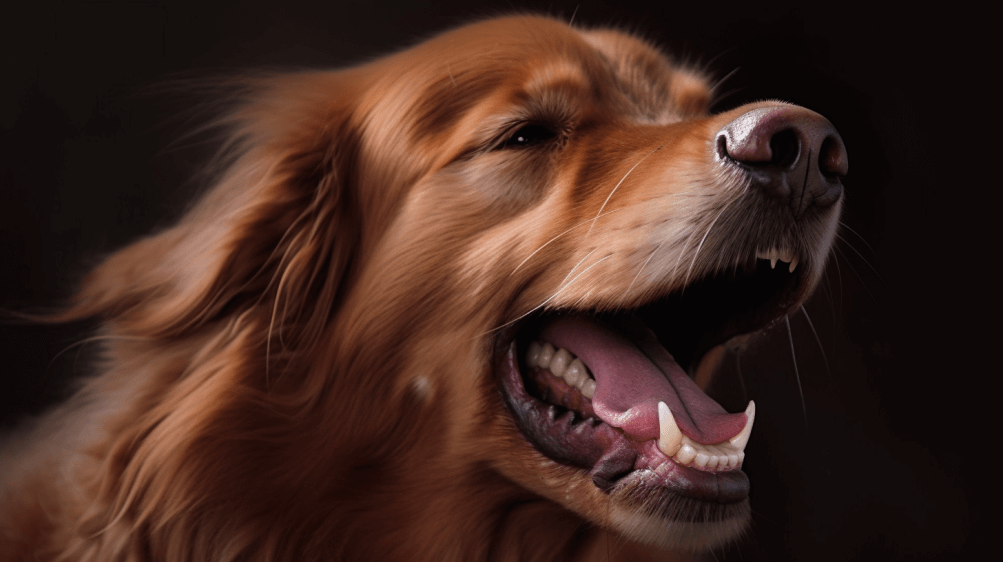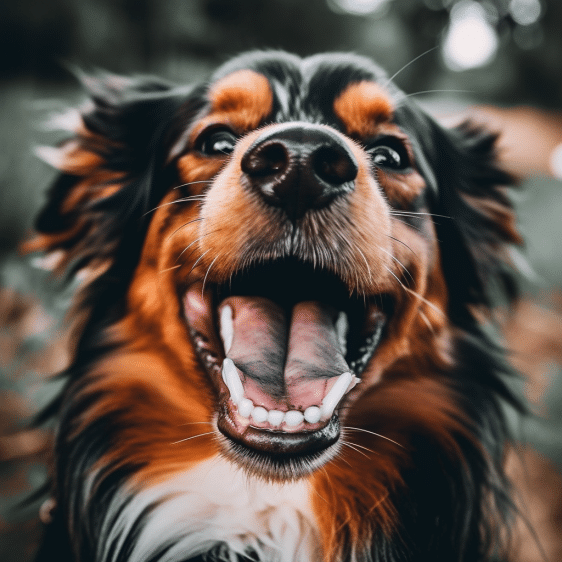Introduction
Hey there, fellow dog lovers! Have you ever noticed your furry friend yawning while you’re giving them some affection?
I know I have, and it made me wonder: “Why does my dog yawn when I pet him?” If you’ve had the same question, you’re in the right place.
Understanding our canine companions’ behavior is essential for building a strong bond and ensuring their happiness.
In this blog post, we’ll dive into the world of dog yawns, explore the reasons behind this curious behavior, and discuss how we can make petting a more enjoyable experience for our four-legged pals.
So, let’s get started on this fascinating journey into the mind of our beloved pets!
Table of contents
Understanding Dog Yawns
The Meaning of a Yawn in Dogs
Many people assume that a dog yawns for the same reasons humans do – either they’re tired or bored. However, in dogs, yawning can serve as a form of communication with a variety of meanings.
Common Misconceptions
- Yawning solely indicates sleepiness
- Yawning suggests boredom
Yawning as a Form of Communication
Yawning is one of the ways dogs communicate their emotions and intentions. They use it to convey different messages depending on the context and their body language.
Different Types of Dog Yawns
There are several types of yawns in dogs, each with a unique meaning.
This table is a handy at a glance guide to dog yawns – with some more detailed explanations below 🙂
| Type of Yawn | Possible Reason | Accompanying Body Language | How to Respond |
|---|---|---|---|
| Tired Yawn | Sleepiness or fatigue | Relaxed posture, droopy eyes | Allow your dog to rest |
| Stress Yawn | Anxiety or discomfort | Lip licking, avoiding eye contact, tense posture | Adjust petting, offer comfort, give space if needed |
| Calming Signal Yawn | Communicating peaceful intentions | Loose body, soft gaze, slow movements | Maintain a calm demeanor, respect your dog’s boundaries |
| Contentment Yawn | Enjoying the petting | Loose wagging tail, soft eyes, relaxed body | Continue petting, reward relaxed behavior |
| Learned Behavior Yawn | Seeking attention or a specific reaction | Varies, may resemble other types of yawns | Determine the cause, avoid reinforcing the behavior |
Tired Yawn
Just like humans, dogs yawn when they’re tired. This type of yawn is a simple expression of fatigue and a signal that they need to rest.
Stress Yawn
Dogs sometimes yawn when they’re feeling stressed or anxious. In this case, the yawn serves as a calming signal, a way for the dog to self-soothe and communicate their discomfort to others.
Calming Signal Yawn
Dogs use calming signals to communicate peaceful intentions and diffuse tense situations. A yawn can be one of these signals, indicating that the dog is trying to maintain a calm and non-threatening demeanor.
Reasons for Yawning When Petted
Relaxation
Yawning as a Sign of Contentment
When a dog yawns while being petted, it can be a sign that they’re feeling content and relaxed. In this context, the yawn serves as a signal of enjoyment and satisfaction.
How Petting Can Induce Relaxation in Dogs
Petting has been proven to release feel-good hormones in both dogs and humans. When you pet your dog, you’re not only providing physical comfort, but you’re also helping them feel more at ease and secure.
Stress and Overstimulation
Yawning as a Stress Signal
Sometimes, a dog might yawn when petted because they’re feeling stressed or overwhelmed. This type of yawn is an attempt to cope with the situation and communicate their discomfort.
The Role of Petting in Causing Stress or Overstimulation
While most dogs enjoy being petted, some may find it overstimulating or stressful. This can happen if the petting is too rough, if the dog is already anxious, or if they’re sensitive to touch in certain areas.
Learned Behavior
Yawning as a Response to Attention
Dogs are quick learners and can easily pick up on patterns in their environment. If a dog has learned that yawning gets them attention or a positive reaction from their owner, they might yawn when petted as a way to solicit more interaction.
Reinforcement of the Yawning Behavior
If the owner reacts to the yawn by giving the dog more attention, the yawning behavior may be reinforced and become more frequent.
How to Respond to a Yawning Dog
When your dog yawns during a petting session, it’s essential to assess the situation and adjust your approach accordingly.
Assessing the Situation
Reading body language: Pay attention to other body language cues like tail wagging, eye contact, and overall posture to determine whether your dog is relaxed or stressed.
Identifying the dog’s emotional state: Use the context of the situation and your dog’s body language to determine if they’re yawning due to relaxation, stress, or a learned behavior.
Adjusting Your Approach
Calming your dog if they are stressed: If your dog is stressed, take a break from petting and try to help them feel more at ease. You can use calming techniques like speaking softly, offering a treat, or engaging in a brain training activity to redirect their focus and reduce anxiety.
- Modifying your petting technique: If your dog seems stressed or overstimulated by the way you’re petting them, try adjusting your approach. You can refer to this comprehensive guide on how to pet a dog for tips on creating a positive experience.
- Giving the dog space if necessary: If your dog continues to yawn or show stress signals, it’s essential to respect their boundaries and give them some space.
Tips for Making Petting More Enjoyable for Your Dog
To ensure your dog enjoys petting sessions, consider these tips:
Understanding Your Dog’s Preferences
Preferred petting spots: Every dog has their favorite spots to be petted. Learn your dog’s preferences and focus on those areas.
Sensitivity to touch: Some dogs may be more sensitive to touch than others. Adjust the pressure and intensity of your petting to match your dog’s comfort level.
Creating a Positive Environment
Reducing stressors: Minimize environmental stressors like loud noises, strangers, or other pets to create a calm atmosphere for petting.
Encouraging relaxation: Encourage your dog to relax by providing a comfortable space and using a calm, soothing voice.
Reinforcing Positive Behavior
- Rewarding your dog for relaxed behavior: When your dog shows signs of relaxation during petting, reward them with praise, treats, or a favorite toy.
- Using positive reinforcement training techniques: Implementing positive reinforcement techniques can help your dog associate petting with positive experiences.
FAQ
Q: Do dogs yawn only when they’re tired?
A: No, dogs yawn for various reasons, including relaxation, stress, or as a learned behavior. It’s essential to consider the context and body language to interpret the yawn accurately.
Q: How can I tell if my dog is yawning because they’re stressed?
A: Look for other signs of stress, like lip licking, avoiding eye contact, or tense body language. If your dog is exhibiting these signs, they may be yawning due to stress.
Q: Can I train my dog to stop yawning when petted?
A: You can try using positive reinforcement training techniques to teach your dog to relax during petting sessions. However, it’s essential to understand the underlying cause of the yawning and address it accordingly.
Q: Are some dog breeds more prone to yawning than others?
A: While there isn’t a specific breed that yawns more than others, some breeds that resemble bears may have more expressive facial features, making their yawns more noticeable.
Q: Can yawning be a sign of a medical issue in dogs?
A: Excessive yawning could be indicative of a medical issue, such as pain or discomfort. If your dog is yawning more than usual or displaying other signs of distress, it’s important to consult your veterinarian.
Q: How do I know if my dog is enjoying the petting session?
A: A relaxed dog will display signs such as a loose, wagging tail, soft eyes, and a calm demeanour. If your dog is yawning due to contentment, their body language will reflect this relaxed state. You can also check out this guide on how to pet a dog for more information on creating a positive petting experience.
Q: Can pregnant dogs yawn more often?
A: Pregnant dogs may display changes in their behavior, including increased yawning. If you suspect your dog might be pregnant, look for other signs such as changes in appetite, nesting behavior, or physical changes. This article on how to tell if a dog is pregnant provides more information on what to look for.
Conclusion
Understanding why your dog yawns when you pet them is crucial for building a strong bond and ensuring their happiness. By paying attention to their body language and adjusting your approach, you can create a more enjoyable petting experience for both you and your dog.



